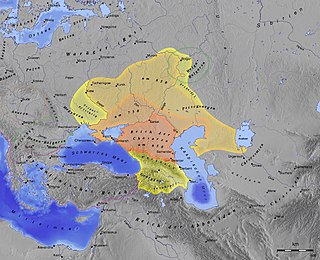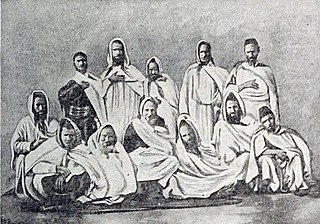
The Khazars were a nomadic Turkic people that, in the late 6th-century CE, established a major commercial empire covering the southeastern section of modern European Russia, southern Ukraine, Crimea, and Kazakhstan. They created what for its duration was the most powerful polity to emerge from the break-up of the Western Turkic Khaganate. Astride a major artery of commerce between Eastern Europe and Southwestern Asia, Khazaria became one of the foremost trading empires of the early medieval world, commanding the western marches of the Silk Road and playing a key commercial role as a crossroad between China, the Middle East and Kievan Rus'. For some three centuries the Khazars dominated the vast area extending from the Volga-Don steppes to the eastern Crimea and the northern Caucasus.
Levites or Levi are Jewish males who claim patrilineal descent from the Tribe of Levi. The Tribe of Levi descended from Levi, the third son of Jacob and Leah. The surname Halevi, which consists of the Hebrew definite article "ה" Ha- ('the') plus Levi ('Levite'), is not conclusive regarding being a Levite; a titular use of HaLevi indicates being a Levite. The daughter of a Levite is a Bat Levi.

Ashkenazi Jews, also known as Ashkenazic Jews or Ashkenazim, constitute a Jewish diaspora population that emerged in the Holy Roman Empire around the end of the first millennium CE. They traditionally spoke Yiddish and largely migrated towards northern and eastern Europe during the late Middle Ages due to persecution. Hebrew was primarily used as a literary and sacred language until its 20th-century revival as a common language in Israel.
Y-chromosomal Aaron is the name given to the hypothesized most recent common ancestor of the patrilineal Jewish priestly caste known as Kohanim. According to the traditional understanding of the Hebrew Bible, this ancestor was Aaron, the brother of Moses.
Jewish ethnic divisions refer to many distinctive communities within the world's Jewish population. Although considered a self-identifying ethnicity, there are distinct ethnic subdivisions among Jews, most of which are primarily the result of geographic branching from an originating Israelite population, mixing with local communities, and subsequent independent evolutions.
The Krymchaks are Jewish ethno-religious communities of Crimea derived from Turkic-speaking adherents of Rabbinic Judaism. They have historically lived in close proximity to the Crimean Karaites, who follow Karaite Judaism.
Several groups of people have claimed lineal descent from the Israelites, an ancient Semitic-speaking people who inhabited Canaan during the Iron Age. The phenomenon has become especially prevalent since the founding of the State of Israel in 1948. The country's Law of Return, which defines Jewishness for the purpose of aliyah, prompted many individuals to claim Israelite ancestry with the expectation that it would make them eligible for Israeli citizenship through their perceived Jewish ethnicity. The abundance of these claims has led to the rise of the question of "who is a Jew?" in order to determine the legitimacy of one's Jewish identity. Some of these claims have been recognized, while other claims are still under review, and others have been outright rejected.
Haplogroup R, or R-M207, is a Y-chromosome DNA haplogroup. It is both numerous and widespread amongst modern populations.

The Ten Lost Tribes were the ten of the Twelve Tribes of Israel that were said to have been exiled from the Kingdom of Israel after its conquest by the Neo-Assyrian Empire c. 722 BCE. These are the tribes of Reuben, Simeon, Dan, Naphtali, Gad, Asher, Issachar, Zebulun, Manasseh, and Ephraim — all but Judah, Benjamin, and some members of the priestly Tribe of Levi, which did not have its own territory.

Berber Jews are the Jewish communities of the Maghreb, in North Africa, who historically spoke Berber languages. Between 1950 and 1970 most emigrated to France, the United States, or Israel.
Haplogroup G-M377 is a Y-chromosome haplogroup and is defined by the presence of the M377 mutation. It is a branch of Haplogroup G2b-M3115, which in turn is defined by the presence of the M3115 mutation. It was found among Pashtuns, who are classified as Iranic and on much lower scale among all major Jewish groups, Palestinians, Lebanese and Syrians(See also page covering Jews with Haplogroup G )

Arthur Koestler was a Hungarian-born author and journalist. Koestler was born in Budapest and, apart from his early school years, was educated in Austria. In 1931, Koestler joined the Communist Party of Germany, but he resigned in 1938 after becoming disillusioned with Stalinism.

The Mokshas comprise a Mordvinian ethnic group belonging to the Volgaic branch of the Finno-Ugric peoples. They live in Russia, mostly near the Volga and Moksha rivers, a tributary of the Oka River.
Genetic studies of Jews are part of the population genetics discipline and are used to analyze the ancestry of Jewish populations, complementing research in other fields such as history, linguistics, archaeology, and paleontology. These studies investigate the origins of various Jewish ethnic divisions. In particular, they examine whether there is a common genetic heritage among them. The medical genetics of Jews are studied for population-specific diseases.
The Japanese-Jewish common ancestry theory is a fringe theory that appeared in the 17th century as a hypothesis which claimed the Japanese people were the main part of the Ten Lost Tribes of Israel. A later version portrayed them as descendants of a tribe of Central Asian Jewish converts to Nestorian Christianity. Some versions of the theory applied to the whole population, but others only claimed that a specific group within the Japanese people had descended from Jews.

The Invention of the Jewish People is a study of Jewish historiography by Shlomo Sand, Professor of History at Tel Aviv University. It has generated a heated controversy. The book was on the best-seller list in Israel for nineteen weeks.

The Khazar hypothesis of Ashkenazi ancestry, often called the Khazar myth by its critics, is a largely abandoned historical hypothesis that postulated that Ashkenazi Jews were primarily, or to a large extent, descended from Khazars, a multi-ethnic conglomerate of mostly Turkic peoples who formed a semi-nomadic khanate in and around the northern and central Caucasus and the Pontic–Caspian steppe. The hypothesis also postulated that after collapse of the Khazar empire, the Khazars fled to Eastern Europe and made up a large part of the Jews there. The hypothesis draws on medieval sources such as the Khazar Correspondence, according to which at some point in the 8th–9th centuries, a small number of Khazars were said by Judah Halevi and Abraham ibn Daud to have converted to Rabbinic Judaism. The scope of the conversion within the Khazar Khanate remains uncertain, but the evidence used to tie the subsequent Ashkenazi communities to the Khazars is meager and subject to conflicting interpretations.
Paul Wexler is an American-born Israeli linguist, and Professor Emeritus of linguistics at Tel Aviv University. His research fields include historical linguistics, bilingualism, Slavic linguistics, creole linguistics, Romani and Jewish languages.
Eran Elhaik is an Israeli-American geneticist and bioinformatician, an associate professor of bioinformatics at Lund University in Sweden and Chief of Science Officer at an ancestry testing company called Ancient DNA Origins owned by Enkigen Genetics Limited, registered in Ireland. His research uses computational, statistical, epidemiological and mathematical approaches to fields such as complex disorders, population genetics, personalised medicine, molecular evolution, genomics, paleogenomics and epigenetics.

1 Chronicles 6 is the sixth chapter of the Books of Chronicles in the Hebrew Bible or the First Book of Chronicles in the Old Testament of the Christian Bible. The book is compiled from older sources by an unknown person or group, designated by modern scholars as "the Chronicler", and had the final shape established in late fifth or fourth century BCE. This chapter focuses on the tribe of Levi, divided into the line of the high priests ; the three lines of the families Gershom, Kohath, and Merari ; the lines of the musicians/singers ; duties of Levites and priests ; list of high priests and the Aaronites' and Levites' settlements. It belongs to the section focusing on the list of genealogies from Adam to the lists of the people returning from exile in Babylon.









